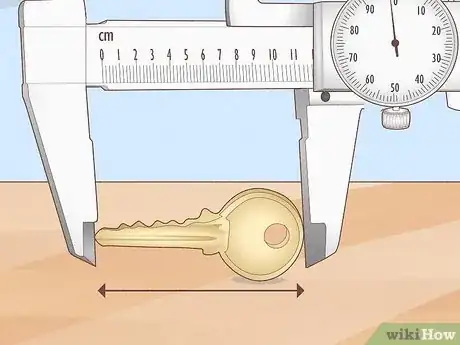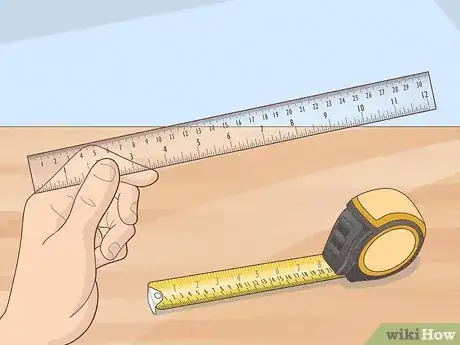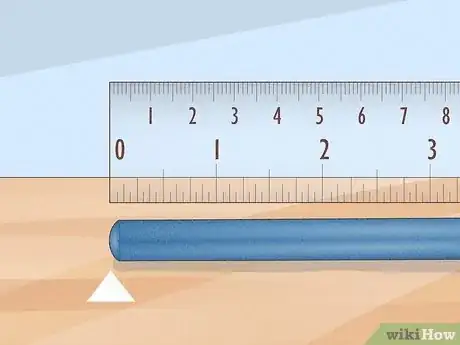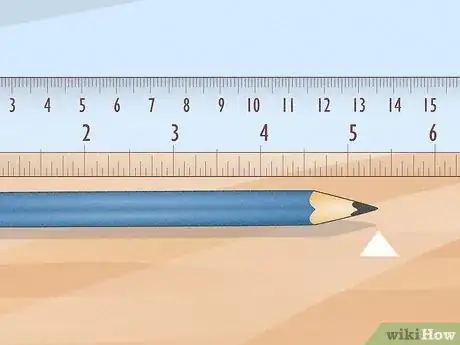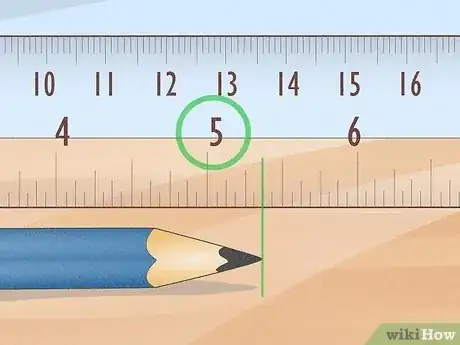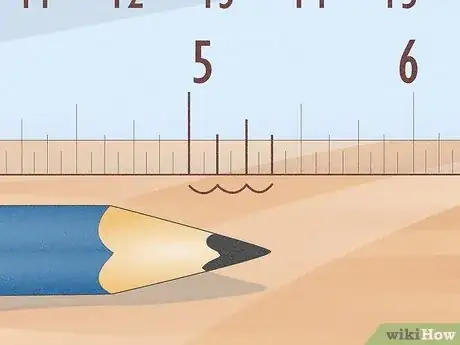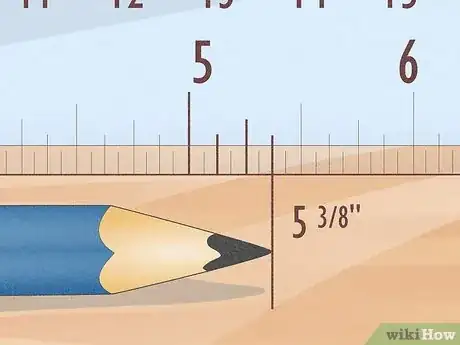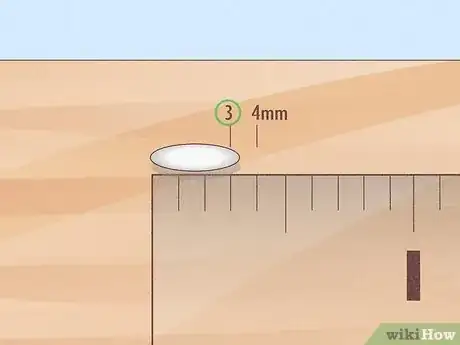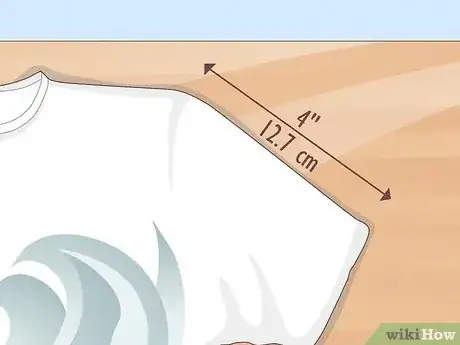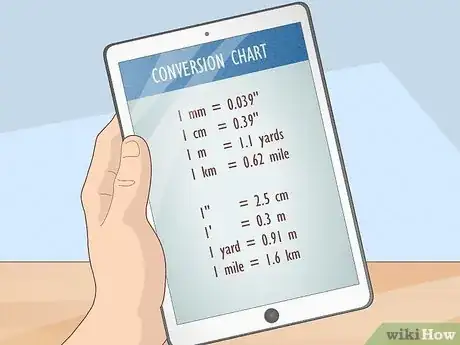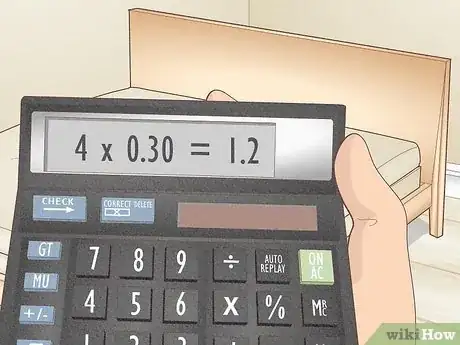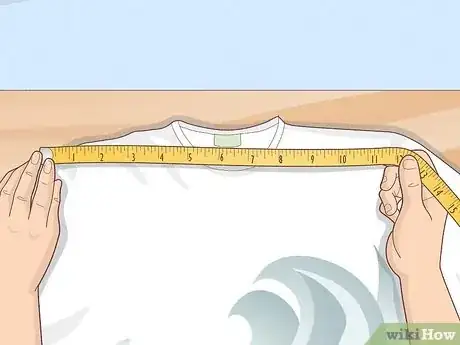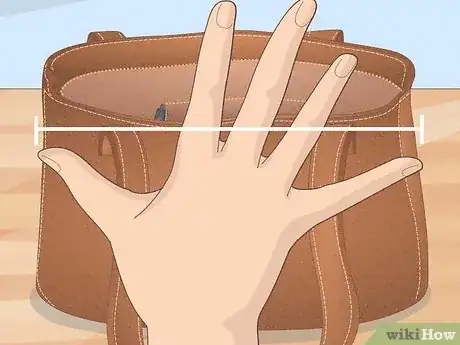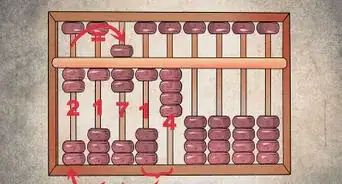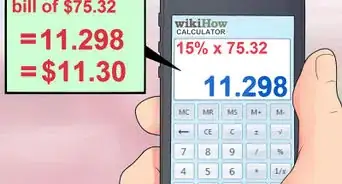This article was co-authored by David Pew and by wikiHow staff writer, Dan Hickey. David Pew is a Professional Tailor and the Owner of Sew Generously based in Seattle, Washington. With over a decade of experience, David specializes in bespoke tailoring and alterations. He uses his experiences, skills, and eye for detail to produce the highest quality of products.
There are 15 references cited in this article, which can be found at the bottom of the page.
This article has been viewed 77,839 times.
Precise measurements are important for crafts, construction projects, home decor, and more—but how do you measure the exact length of something? With the right measuring tool and technique, finding length down to the millimeter or 16th of an inch is a breeze. That’s why we’ve put together a handy guide to measuring length in both the metric and imperial systems. If you’re ready to measure up everything you own (and even yourself), keep scrolling!
Steps
Measuring Object Lengths
-
1Use a measuring tool with the right units for your measuring system. Some measuring tools show markings for imperial and metric units, while some show only one system. Eyeball the length of the object or surface you’re measuring and grab a measurer that looks just as long or longer: [4]
- Use a ruler for objects smaller than a piece of paper. Imperial rulers are 1 foot long and metric rulers are 30 centimeters long.
- Use a yardstick or meter stick for medium objects bigger than a ruler. Yardsticks are 3 feet long (36 inches) and meter sticks are 1 meter long (100 centimeters).
- Use a tape measure for long objects, like the length of a room. Imperial tape measures use feet and inches, and metric ones use meters and centimeters.
-
2Line up one end of the object with the 0 (zero) mark on your measurer. When you use a ruler, look carefully for the 0 mark—it’s at the very end of some measuring sticks, but sometimes it’s away from the end.[5] On tape measures, the 0 mark is the edge of the metal clip (the tang) at the end of the tape.[6]
- Make sure the object and your measuring tool are lined up straight with each other. Otherwise, your measurement will be a diagonal instead of the straight length.
- Double check that your measuring tool reaches all the way along the object’s length. If it’s too short, grab a bigger measurer.
-
3Look how far the object reaches on the measurer to read its length. Measuring tools use tick marks to help you see how many units long an object is. Read the tick mark closest to the other end of your object to see its length. Metric and imperial rulers use different sets of tick marks:[7]
-
Metric rulers: The biggest tick marks show centimeters. These tick marks have numbers by them to help you count centimeters easily.
- There are 9 smaller tick marks inside each centimeter. These smaller ticks are millimeters (there are 10 millimeters in 1 centimeter).
-
Imperial rulers: The biggest tick marks with numbers are inches. Inches have different-sized ticks inside for different divisions:
- The largest ticks between inches are half inches.
- The mid-sized ticks between half inches are quarter inches.
- The second-smallest ticks between quarter inches are eighth inches.
- The smallest tick marks between eighth inches are sixteenth inches.
- Read measuring tapes the same way you’d read a ruler or measuring stick. The only difference is the extra markings that show feet or meters.
-
Metric rulers: The biggest tick marks show centimeters. These tick marks have numbers by them to help you count centimeters easily.
-
4Choose the smaller whole number if the object ends between 2 units. Look at the end of the object—if it lands between 2 whole numbers (the big ticks for centimeters or inches), then choose the lower of the 2 numbers. The length of the object is that number of units, plus a fraction of another unit.[8]
- For example, if the tip of a pencil lands between the 5-inch mark and the 6-inch mark, the pencil is 5 inches plus a fraction of another inch long.
- If the pencil tip landed exactly on the 5-inch mark, then it’s exactly 5 inches long.
-
5Count the tick marks after your whole number. Each tick mark is a fraction of a unit. On metric rulers, every tick is 1 millimeter (1/10th of a centimeter). On imperial rulers, the smallest ticks are 1/16th of an inch. The longer ticks outline eighths, quarters, and halves of an inch for easier counting.[9]
- If the pencil tip lands past the 5-inch mark, count tick marks from “5” to the tip. If you count 3 eighth-inch ticks, then the pencil is an extra ⅜ inch long.
-
6Add your whole number and fraction together. The total of these measurements is the total length of your object. In our pencil example, add 5 inches to ⅜ inch. The total length of the pencil is 5 and ⅜ inches![10]
-
7Round your measurement if the object ends between 2 tick marks. See which tick the end of the object is closest too. Round your answer to this tick mark since it’s the most accurate. For example, if something is closer to the 3rd millimeter tick mark than the 4th millimeter tick mark, call it 3 millimeters long.[11]
- Consider why you're measuring when you round. If you’re measuring wood to cut, for example, round up since you can always cut off more.[12]
Converting Metric and Imperial Units
-
1Convert units to find length in a different measurement system. Since different countries use different systems, it’s helpful to know how to state an object’s length in both metric and imperial units. For example:[13]
- Pretend you’re an American who wants to buy a shirt in France. You know your sleeve length in inches, but French stores measure clothes in centimeters. You’ll have to convert your sleeve length to centimeters to buy the right size.
- Some countries, like Canada, use a mix of both systems. In these places, knowing how to convert is very helpful![14]
- Some measuring tools have both metric and imperial tick marks. In this case, just read the ruler instead of converting units.
-
2Look up how many metric units fit inside imperial units and vice versa. Say you’re converting feet to meters—you’ll need to know how many imperial feet there are in 1 metric meter to make an accurate conversion. Use a conversion chart for quick reference:[15]
- Metric to imperial conversions:[16]
- 1 millimeter = 0.039 inches
- 1 centimeter = 0.39 inches
- 1 meter = 1.1 yards
- 1 kilometer = 0.62 miles
- Imperial to metric conversions:
- 1 inch = 2.5 centimeters
- 1 foot = 0.3 meters
- 1 yard = 0.91 meters
- 1 mile = 1.6 kilometers
- Metric to imperial conversions:[16]
-
3Multiply your measurement value by the corresponding conversion factor. Pretend you have a headboard that is 4 feet long, but need to know how many meters long it is. Multiply your measurement (4) by the number of meters per foot (0.30) to get the length in meters (1.2 meters).[17]
- Alternatively, use an online conversion tool like Calculator.net for fast and accurate conversions.
Community Q&A
-
QuestionHow many inches are in a yard?
 wikiHow Staff EditorThis answer was written by one of our trained team of researchers who validated it for accuracy and comprehensiveness.
wikiHow Staff EditorThis answer was written by one of our trained team of researchers who validated it for accuracy and comprehensiveness.
Staff Answer wikiHow Staff EditorStaff AnswerThere are 36 inches in 1 yard. A yard has 3 feet, and each foot is equal to 12 inches. When you add 3 feet together, you get 36 inches.
wikiHow Staff EditorStaff AnswerThere are 36 inches in 1 yard. A yard has 3 feet, and each foot is equal to 12 inches. When you add 3 feet together, you get 36 inches. -
QuestionHow do I convert centimeters into millimeters?
 DonaganTop AnswererMultiply the number of centimeters by 10 to get millimeters.
DonaganTop AnswererMultiply the number of centimeters by 10 to get millimeters.
References
- ↑ https://dictionary.cambridge.org/us/dictionary/english/length
- ↑ https://www.mathsisfun.com/definitions/unit-of-measurement.html
- ↑ https://www.worldatlas.com/articles/what-countries-use-the-metric-system.html
- ↑ https://flexbooks.ck12.org/cbook/ck-12-conceptos-de-matem%C3%A1ticas-de-la-escuela-secundaria-grado-6-en-espa%C3%B1ol/section/2.3/related/lesson/appropriate-measurement-tools-msm6/
- ↑ https://virtualnerd.com/middle-math/measurement/customary-system/measure-ruler-inches
- ↑ https://www.bobvila.com/articles/how-to-use-a-tape-measure/
- ↑ https://www.inchcalculator.com/how-to-read-a-ruler/
- ↑ https://virtualnerd.com/middle-math/measurement/customary-system/measure-ruler-inches
- ↑ https://virtualnerd.com/middle-math/measurement/customary-system/measure-ruler-inches
- ↑ https://virtualnerd.com/middle-math/measurement/customary-system/measure-ruler-inches
- ↑ https://virtualnerd.com/middle-math/measurement/customary-system/measure-ruler-inches
- ↑ https://www.bobvila.com/articles/how-to-use-a-tape-measure/
- ↑ https://www.mathsisfun.com/metric-imperial-conversion-charts.html
- ↑ https://angusreid.org/metric/
- ↑ https://www.mathsisfun.com/imperial-metric-conversion.html
- ↑ https://www.mathsisfun.com/metric-imperial-conversion-charts.html
- ↑ https://www.mathsisfun.com/imperial-metric-conversion.html
- ↑ https://www.artofmanliness.com/style/clothing/measuring-the-man-how-to-measure-yourself-for-clothing-plus-a-bonus-personal-sizing-card/
- ↑ https://youtu.be/yQJ7hxDywT0?t=97
- ↑ https://youtu.be/WXOZ6_TixFA?t=11
- ↑ https://vehq.com/how-to-read-odometer/
- ↑ https://www.bbc.co.uk/bitesize/topics/z2c9q6f/articles/zrrvqp3
About This Article
To measure the length of an object, choose the correct tool for measuring it, like a ruler for small, flat items, or a measuring tape for items with curves. Then, line up the zero mark on your measuring tool with one end of the object. Make sure to keep your measuring device perpendicular to the edge of the object so you get an accurate measurement. Finally, note the number on your tool that's closest to the other end of the object. For tips on how to measure using the metric system, keep reading!
